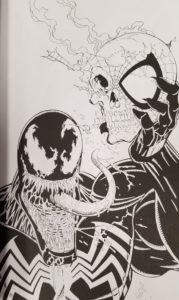One of my fondest childhood memories is colouring with my mom. We had numerous colouring books and those big boxes of Crayola crayons—the ones that came with the built-in sharpener in the box—and we’d sit for hours and just colour. I always tried to emulate the way she’d trace darker lines along the inside edges of each element on the page, then colour it in with a lighter stroke. My unskilled hand never managed to get the texture and direction just right, but it was all about the experience and the time spent together.
Today, colouring books have taken on a different meaning for me. They are a mindfulness moment where I disconnect from the world and just focus on, well, colouring. They can also be an activity that I can share with my friends or my own daughters or with my cat. I like to use lots of different media, from various kinds of markers to pencil crayons to watercolours to gel pens, but lately, it’s all come back to good old Crayola crayons. Now I have a collection of twistable crayons, so no more built-in sharpeners for me.
When it comes to picking out a colouring book, I’m learning that there are specific elements that do or don’t work for my tastes specifically, or for a colouring book as a whole. First of all, I love geeky colouring books and I appreciate that comic book publishers have recognized their value and given me lots to choose from. Or given you lots to choose from, if you’re looking to buy me a gift. Here are some dos and don’ts that can make or break a geeky colouring book.
Mandalas and Patterns
Mandalas are a big deal in the standard adult colouring books that you can find on the shelves. They are considered ritualistically and spiritually symbolic to Hinduism and Buddhism, but the repetitive patterns have become common place in adult colouring books and have morphed beyond the circular images. Whether surrounding swear words, or moulded into animal shapes, it’s far less about spiritualism than it is about filling the page.
Geeky colouring books don’t often feature mandalas, opting to focus on cover art and splash pages typically found in previously published comics. A page full of intricate, repetitive patterns are too much for my flighty brain, but a nice combination of patterns and my favourite characters work well, as with The Witcher colouring book from Dark Horse.
Character Variation
As much as I love the Wonder Woman colouring book, I’ve come to the realization that colouring books featuring a single character don’t leave a lot of room for fun. I mean, sure, I could colour Wonder Woman’s outfit in different colours—no, I can’t. I can’t do that. It feels wrong, okay?—but after awhile, it becomes the same old, same old. Like Wonder Woman, a Superman or Spider-Man comic means that the primary colours in your collection are going to take a beating. Fortunately, these books often feature pages with a few friends dropping by, or lots of background imagery to make up for the monotony. Team books are the way to go to avoid this monotony, or solo characters that aren’t bound to a single look and colour scheme.
Tell Me a Story
Colourists play an extremely important role in shaping the comics we read. If you want to get a tiny taste of what they do, you can check out colouring books that let you colour entire story arcs, like DC’s Batman: Hush or Batman: Mad Love Featuring Harley Quinn, from panel to panel.
The Blackness of Space
The whole point of colouring books is to colour in them, so it kills me to see books that offer pages that are mostly black ink. What’s the point of including a page like that when there is no room for the artist to add any kind of variety of colour to the page? This is especially ridiculous when the characters themselves are mainly dressed in black. At least colouring Wonder Woman involves four main colours. Whose bright idea was it to make Venom or Darth Vader colouring books?
Both of these are great, fan favourite characters, but the problem with making them the subject of a colouring book ought to be obvious. Sure, some of the pages feature a few other elements to colour, like a wall, or Spider-Man, or a lightsaber, but the whole point of a colouring book is to be able to colour. There’s little satisfaction in the book that severely limits that option.
The Whiteness of Space
Conversely, when a colouring book features too much white space, it makes me fearful for the longevity of my colouring tools, or just plain bored with the idea of colouring a big chunk of empty space. A good colouring book needs to be proportionate when it comes to detail and space to colour.
The Tank Girl Coloring Book is high on my list of favourites because, other than a few misses in the pages, it meets a lot of my discerning criteria. Recently coming in at a close second are the Grimm Fairy Tales colouring books, which came in a gorgeous — colourable — box, with new pencil crayons and additional postcards for me to colour.
https://www.instagram.com/p/BrBm-zGhF3O/
Comic and video game colouring books might just be a trend, but it’s one that I sincerely hope does not pass on anytime soon. If publishers put a little bit of effort into curating their colouring books, more kids and grown ups alike might find themselves in need of a shiny new set of crayons.



